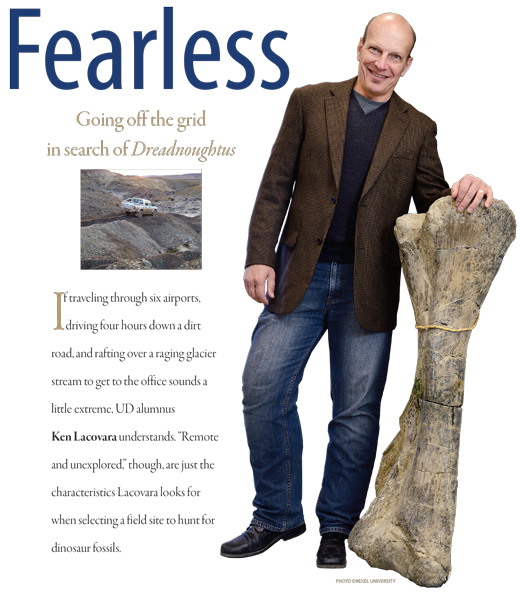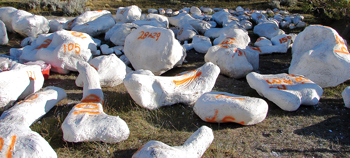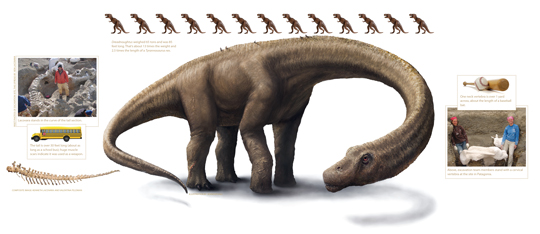
ALUMNI & FRIENDS | Lacovara, EOE98PhD, who earned his doctoral degree in geology, is an associate professor in the department of biodiversity, earth and environmental science at Drexel University in Philadelphia. He gained the world’s attention last fall when he revealed the discovery of a new supermassive sauropod dinosaur species unearthed in southern Patagonia, Argentina.

Dreadnoughtus schrani is the most complete skeleton ever found of a supermassive dinosaur. In life it would have measured 85 feet long and weighed 65 tons, as much as 13 African elephants or more than seven Tyrannosaurus rex.
The 77-million-year-old creature belongs to a group of large plant eaters known as titanosaurs. It was unearthed during fieldwork from 2005-2009, along with a smaller, less complete skeleton found at the same time.
Finding a supergiant
To find dinosaur fossils, paleontologists use geological maps to search for sedimentary rocks of the right age, located in dry, arid environments.
“In pictures, it always looks like paleontologists work in deserts. This is not because these creatures lived in deserts, rather it is because where you have deserts today you have good exposure of the rock, which is necessary to locate fossils,” Lacovara says.
Serendipity plays a part, too, in whether the samples found are well-preserved, worthy of study or new to science.
Most dinosaur fossils have been found in the western United States, China and Patagonia. Lacovara, a paleontologist with a background in geology and sedimentology, selected southern Patagonia because geological maps indicated the location contained vast swaths of Cretaceous age sediments.
It took four field seasons, each two months long, and a team of volunteers and students to excavate the 16-ton skeleton from approximately 150-200 tons of rock that was removed. Horses initially were used to bring supplies in and to transport dinosaur fossil bones out, some weighing hundreds of pounds, before a path was cleared to provide automobile access. Dozens of people assisted with logistics, permitting, insurance, shipping and more.
“In the field you are never comfortable, you are always hot or cold, tired or hungry. But when you hammer at the rock with a chisel [and reveal] something that no human has ever seen in history, you know that you’ve made an unassailable contribution to the stock of reality. It’s addictive,” says Lacovara, who previously worked on successful projects in the Egyptian Sahara and the Gobi Desert of China.
Lacovara enlisted collaborators at Drexel’s Academy of Natural Sciences and Carnegie Museum of Pittsburgh to help his research team prepare and preserve the fossils. Thousands of hours were spent etching away millions of years of sediment and stabilizing the bones with special epoxies and chemicals, then digitizing the skeleton using a 3-D laser scanner.
Three-dimensional digital modeling, he says, is the future in paleontology, particularly for studying giant dinosaurs, because it eliminates the weight of the bones; the data doesn’t decay over time like bone specimens can, and information can be ported around the world with the click of a button.
The 3-D laser scans also provide new insight into the animal’s physiology, particularly the function and force of its muscles—information that is generally lacking for sauropods. Future research will include working to understand the dinosaur’s musculature, growth rate and biomechanics, as well as its relationship to the environment.

The science of the super-sized
While scientists today can still observe and study blue whales, the biggest creatures to ever occupy the ocean, the largest creatures to walk on the land are extinct.
Before Dreadnoughtus, scientists have only known these land giants from very fragmentary remains. The most complete skeleton found prior to Dreadnoughtus was 26 percent complete. Dreadnoughtus is over 70 percent complete and includes 145 bones.
Lacovara calculated the animal’s mass using measurements from the femur and humerus, both of which were found at the field site. Having found both allows him to estimate the animal’s weight with confidence. Another Patagonian giant, Elaltitan, previously held the title of the dinosaur with the greatest reliably calculable weight at 47 tons.
The discovery will push biological frontiers by providing paleontologists important clues on how big land animals can get.
“For the first time, we can see a near complete skeletal anatomy of one of the most massive creatures to walk the earth. It’s just the early stages, but I think we will learn more about the physiology of supermassive land animals from Dreadnoughtus than we have from any of these creatures in the past,” said Lacovara.
How many Dreadnoughtus were there?
Lacovara named the dinosaur Dreadnoughtus after Dreadnoughts—huge, impervious battleships from the early 20th century. The species name, “schrani,” honors American entrepreneur Adam Schran, who supported the research.
But just how many Dreadnoughtus lived during this time period?
According to Lacovara, the Cretaceous period was a bountiful time in Earth’s history with high temperatures and carbon dioxide levels that would have led to high levels of plant production and abundant food resources.
Dreadnoughtus was not fully grown when it died and scientists are unsure how big it might have gotten. Some animals, like humans, grow for a specific amount of years, while others, like leatherback sea turtles, grow continuously. Lacovara suspects large dinosaurs may have continued growing throughout their lifetime.
“We really don’t know at this point, but it raises many questions. Large dinosaurs often are known from a single specimen. It’s not clear whether the size variation we observe relates to differences between species or simply different life ages of the individuals collected,” he says.
How Dreadnoughtus died, however, is easier to decipher. River deposits and storm deposit sediments found in the earth surrounding the giant sauropod indicate that the animal succumbed when a nearby river overflowed its banks, turning the surrounding flood plain into quick sand.
Global warming has increased the importance of studying Mesozoic ecosystems, particularly those of the Cretaceous Period, because fossil ecosystems offer the only tangible evidence of what continued global warming might produce in the future.
The dinosaur fossil was returned to South America earlier this year, to the Padre Jesús Molina Regional Museum, a small museum in the Santa Cruz province, Argentina.
Lacovara admits that watching the subject of a decade’s work depart the Port of Philadelphia brought mixed emotions, but says he is heartened by the fact that a 3-D printed version of Dreadnoughtus is planned for display at the Academy of Natural Sciences in Philadelphia.
Article by Karen B. Roberts, AS90
Photos by Ken Lacovara and Drexel University. Composite Image of Dinosaur by Kenneth Lacovara and Valentina Feldman





